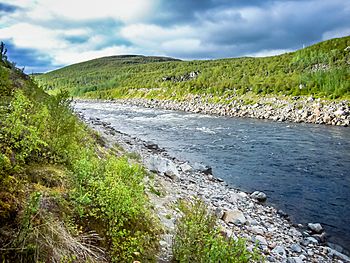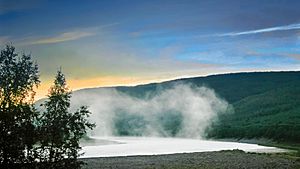Tana (Norway) facts for kids
Quick facts for kids Tana |
|
|---|---|

View of the river
|
|
| Other name(s) | Tenojoki / Deatnu / Tana älv |
| Countries | |
| Regions |
|
| Physical characteristics | |
| Main source | Anarjohka-Karasjohka North of Karigasniemi, Norway-Finland border 125 m (410 ft) 69°26′03″N 25°48′13″E / 69.43417°N 25.80361°E |
| River mouth | Tanafjorden Tana Municipality, Troms og Finnmark, Norway 0 m (0 ft) 70°07′12″N 28°34′22″E / 70.12000°N 28.57278°E |
| Length | 361 km (224 mi) |
| Basin features | |
| River system | Karasjohka |
| Basin size | 16,377 km2 (6,323 sq mi) |
The Tana River is a long river, about 361 km (224 mi) (224 miles) in length. It flows through the northern part of Fennoscandia, a region in Europe. This river forms part of the border between two countries: Norway and Finland.
The Tana River is very important to the Sámi people who live in the Tana Valley. They call it "Deatnu," which means "Great River." For centuries, fishing, especially for salmon, has been a major way of life for the Sámi people here. The main rivers that flow into the Tana are the Anarjohka and Karasjohka.
Contents
Where is the Tana River?
The Tana River starts near the border of Norway and Finland. For about 256 km (159 mi) (159 miles), it forms the border between the Finnish municipality of Utsjoki and the Norwegian municipalities of Karasjok and Tana.
It is the fifth longest river in Norway. The last 105 kilometres (65 mi) (65 miles) of the river flow completely within the Tana municipality in Norway. The river then empties into the Tanafjorden, which is a large bay. The area where the river meets the sea is called a river delta. The Tana River delta is one of the biggest and most natural river deltas in Europe. It is a protected area and a vital home for many different kinds of wetland birds. When the tide is low, you can see large sandbars in the delta.
Fishing in the Tana River
The Tana River is famous for its excellent salmon fishing. It is known as the most productive salmon river in both Finland and Norway.
- Fishing Rules: Fishing in the Tana River is carefully managed by both Finland and Norway.
- Recent Changes: In 2022, salmon fishing was not allowed in the river by authorities in both countries. In 2023, on the Finnish side, some special permits were given to fish for humpback salmon using methods like drift netting and seine fishing.
- Past Catches: In 2020, about 18,600 kilograms (41,000 lb) (41,000 pounds) of salmon were caught in the river. In 2002, fishermen caught a much larger amount: about 99,546 kilograms (219,461 lb) (219,460 pounds) of salmon. The average size of these salmon was 4.5 kilograms (9.9 lb) (9.9 pounds). That same year, about 4,426 kilograms (9,758 lb) (9,757 pounds) of sea trout were also caught.
- Fishing Permits: When fishing is allowed, people can buy a fishing permit for angling (fishing with a rod and line). Some local residents can get special permits to fish with barrier nets.
- World Record Salmon: The Tana River holds the world record for the largest Atlantic salmon ever caught. It weighed an amazing 36 kilograms (79 lb) (79 pounds) and was caught in 1929 by Nils Mathis Walle.
- Humpback Salmon Barrier: In 2023, Norwegian authorities built a special barrier with a trap. This helps to sort out hundreds of humpback salmon, while allowing other fish to pass through. This barrier is located near Seidaholmen.
How People Travel on and Around the Tana River
- Tana Bridge: The Tana Bridge, also called Nybrua, was built in 2020. It replaced an older bridge from 1948. The main part of this new bridge is 234 metres (768 ft) (768 feet) long.
- Sami Bridge: The Sami Bridge near Utsjoki was built in 1993.
- Roads: The European route E6 highway runs along the western side of the river for most of its length.
- Ice Roads: In winter, when the river freezes, two ice roads are usually open from December to April. These roads are near Rustefjelbma and Polmak. They have a weight limit of 2 tonnes (2.0 long tons; 2.2 short tons) (2.2 short tons), but few other restrictions.
See also
 In Spanish: Río Tana (Noruega-Finlandia) para niños
In Spanish: Río Tana (Noruega-Finlandia) para niños


